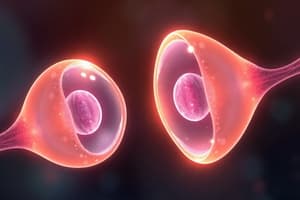Podcast
Questions and Answers
What is the primary outcome of Meiosis I?
What is the primary outcome of Meiosis I?
- Chromosome number is reduced to half in each daughter cell (correct)
- Sister chromatids separate to form identical cells
- Chromatids are replicated to produce diploid cells
- Crossing over occurs resulting in the creation of new cells
During which phase of meiosis does crossing-over occur?
During which phase of meiosis does crossing-over occur?
- Metaphase I
- Telophase I
- Prophase I (correct)
- Anaphase II
What distinguishes haploid cells from diploid cells?
What distinguishes haploid cells from diploid cells?
- Diploid cells are formed through fertilization, while haploid cells are formed during binary fission.
- Haploid cells contain one set of chromosomes, while diploid cells contain two sets. (correct)
- Diploid cells have undergone mitosis, while haploid cells have not.
- Haploid cells are present only in plants, while diploid cells are found in all organisms.
In the alteration of generations, which phase produces haploid gametes?
In the alteration of generations, which phase produces haploid gametes?
Which phase of meiosis II is characterized by the separation of sister chromatids?
Which phase of meiosis II is characterized by the separation of sister chromatids?
Which of the following best describes polyploidy?
Which of the following best describes polyploidy?
What is formed at the end of Telophase II?
What is formed at the end of Telophase II?
Which event does NOT occur during Meiosis II?
Which event does NOT occur during Meiosis II?
What is the primary outcome of meiosis in sporocytes?
What is the primary outcome of meiosis in sporocytes?
Which of the following describes haploid cells?
Which of the following describes haploid cells?
In the alternation of generations, what is formed at the end of the gametophyte phase?
In the alternation of generations, what is formed at the end of the gametophyte phase?
Which type of organism most prominently exhibits alternation of generations?
Which type of organism most prominently exhibits alternation of generations?
What defines polyploid cells?
What defines polyploid cells?
Which of the following statements is true regarding sporophyte cells?
Which of the following statements is true regarding sporophyte cells?
What is the role of zygotes in the alternation of generations?
What is the role of zygotes in the alternation of generations?
Which of the following correctly describes the change from sporophyte generation to gametophyte generation?
Which of the following correctly describes the change from sporophyte generation to gametophyte generation?
In plants, what occurs during the gametophyte phase of the alteration of generations?
In plants, what occurs during the gametophyte phase of the alteration of generations?
What is the haploid state in the life cycle of plants known as?
What is the haploid state in the life cycle of plants known as?
Which statement correctly describes polyploidy in organisms?
Which statement correctly describes polyploidy in organisms?
What is the term for chromosome pairs that are identical in length and gene location?
What is the term for chromosome pairs that are identical in length and gene location?
What happens during Division I of meiosis?
What happens during Division I of meiosis?
Which of the following is NOT a characteristic of asexual reproduction?
Which of the following is NOT a characteristic of asexual reproduction?
Flashcards
Diploid cell
Diploid cell
A cell containing two sets of chromosomes (2x).
Haploid cell
Haploid cell
A cell containing one set of chromosomes (1x).
Polyploid cell
Polyploid cell
A cell containing more than two sets of chromosomes.
Gamete
Gamete
Signup and view all the flashcards
Sporophyte
Sporophyte
Signup and view all the flashcards
Gametophyte
Gametophyte
Signup and view all the flashcards
Alternation of Generations
Alternation of Generations
Signup and view all the flashcards
Meiosis
Meiosis
Signup and view all the flashcards
Meiosis I (Reduction Division)
Meiosis I (Reduction Division)
Signup and view all the flashcards
Meiosis II (Equational Division)
Meiosis II (Equational Division)
Signup and view all the flashcards
Prophase I
Prophase I
Signup and view all the flashcards
Crossing Over
Crossing Over
Signup and view all the flashcards
Metaphase I
Metaphase I
Signup and view all the flashcards
Anaphase I
Anaphase I
Signup and view all the flashcards
Telophase I
Telophase I
Signup and view all the flashcards
Meiosis Gamete Production
Meiosis Gamete Production
Signup and view all the flashcards
Asexual Reproduction
Asexual Reproduction
Signup and view all the flashcards
Sexual Reproduction
Sexual Reproduction
Signup and view all the flashcards
Homologous Chromosomes
Homologous Chromosomes
Signup and view all the flashcards
Meiosis Result
Meiosis Result
Signup and view all the flashcards
Meiosis DNA Replication
Meiosis DNA Replication
Signup and view all the flashcards
Centromere
Centromere
Signup and view all the flashcards
Mitosis vs. Meiosis
Mitosis vs. Meiosis
Signup and view all the flashcards
Chromosome Number Reduction
Chromosome Number Reduction
Signup and view all the flashcards
Study Notes
Meiosis and Alternation of Generations
- Meiosis is a process that reduces the number of chromosomes in a cell to half.
- Learning changes everything.
- Asexual reproduction produces identical cells.
- Sexual reproduction forms seeds in flowering/cone-bearing plants.
- Gametes (egg and sperm) unite to form a zygote.
Phases of Meiosis
- Meiosis I (Reduction Division): Reduces the number of chromosomes to half.
- Meiosis II (Equational Division): No further reduction in chromosome number.
- DNA molecules double before meiosis.
- Each chromosome has identical DNA molecules held together by a centromere.
Alteration of Generations
- Meiosis results in half the number of chromosome sets in a gamete.
- Haploid (1x) cell: Cell with one set of chromosomes.
- Diploid (2x) cell: Cell with two sets of chromosomes.
- Zygote: Fertilized egg.
- Polyploid cell: Cell with more than two sets of chromosomes.
- Triploid (3x) cell: Three sets of chromosomes.
- Homologous chromosomes cannot pair properly in some cases, which causes unviable gametes.
- Examples of polyploids include: navel oranges and seedless watermelons.
- Hexaploid (6x) and Octaploid (8x) are other polyploid examples.
Sporophytes
- Sporophytes develop from zygotes and produce sporocytes.
- Sporocytes undergo meiosis to produce haploid spores.
Gametophytes
- Gametophytes develop from spores.
- Gametophytes form cells/structures to create gametes.
- Fertilization fuses gametes to form a zygote.
Organisms with Alternation of Generations
- Alternation of generations: Life cycle with sexual reproduction between diploid sporophyte and haploid gametophyte phases.
- This pattern can be seen in protists, fungi, and plants.
- It's most evident in the plant kingdom.
Rules for Alteration of Generations
- The first cell of a gametophyte is a spore, and the last is a gamete.
- A gametophyte cell contains half the chromosomes as the sporophyte.
- The first cell of a sporophyte is a zygote, and the last is a sporocyte.
- A sporophyte cell contains twice as many chromosomes as a gametophyte.
- Changes from sporophyte to gametophyte occur via meiosis.
- Changes from gametophyte to sporophyte occur via fertilization.
Studying That Suits You
Use AI to generate personalized quizzes and flashcards to suit your learning preferences.
Related Documents
Description
This quiz covers the fundamental concepts of meiosis and the alternation of generations in plants. It explores the phases of meiosis, the significance of haploid and diploid cells, and the formation of gametes. Test your understanding of how sexual and asexual reproduction contributes to genetic diversity.



